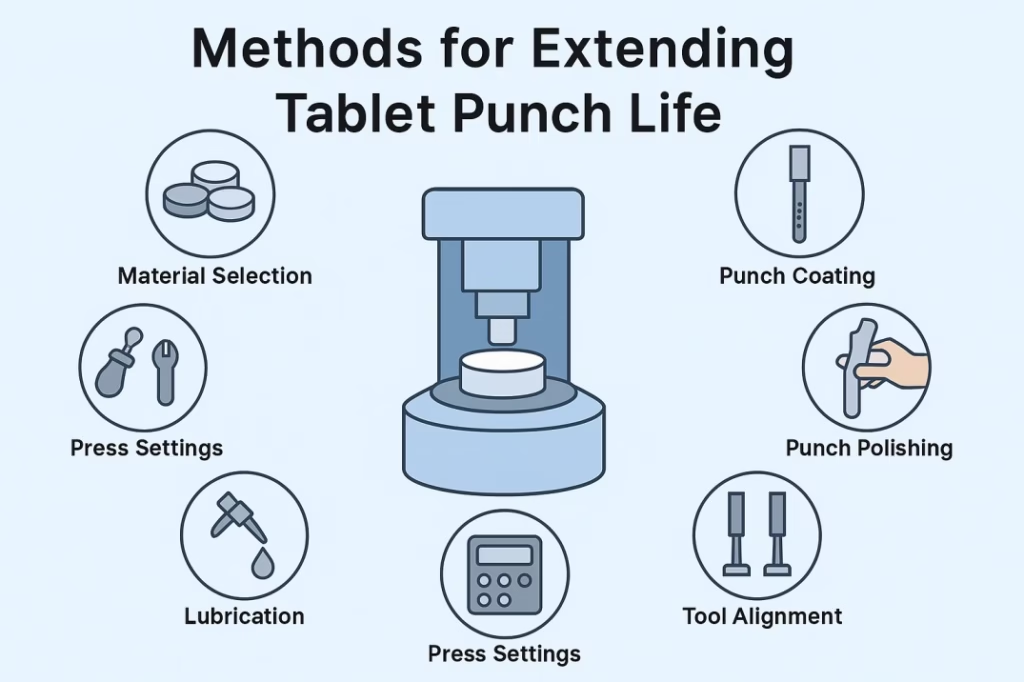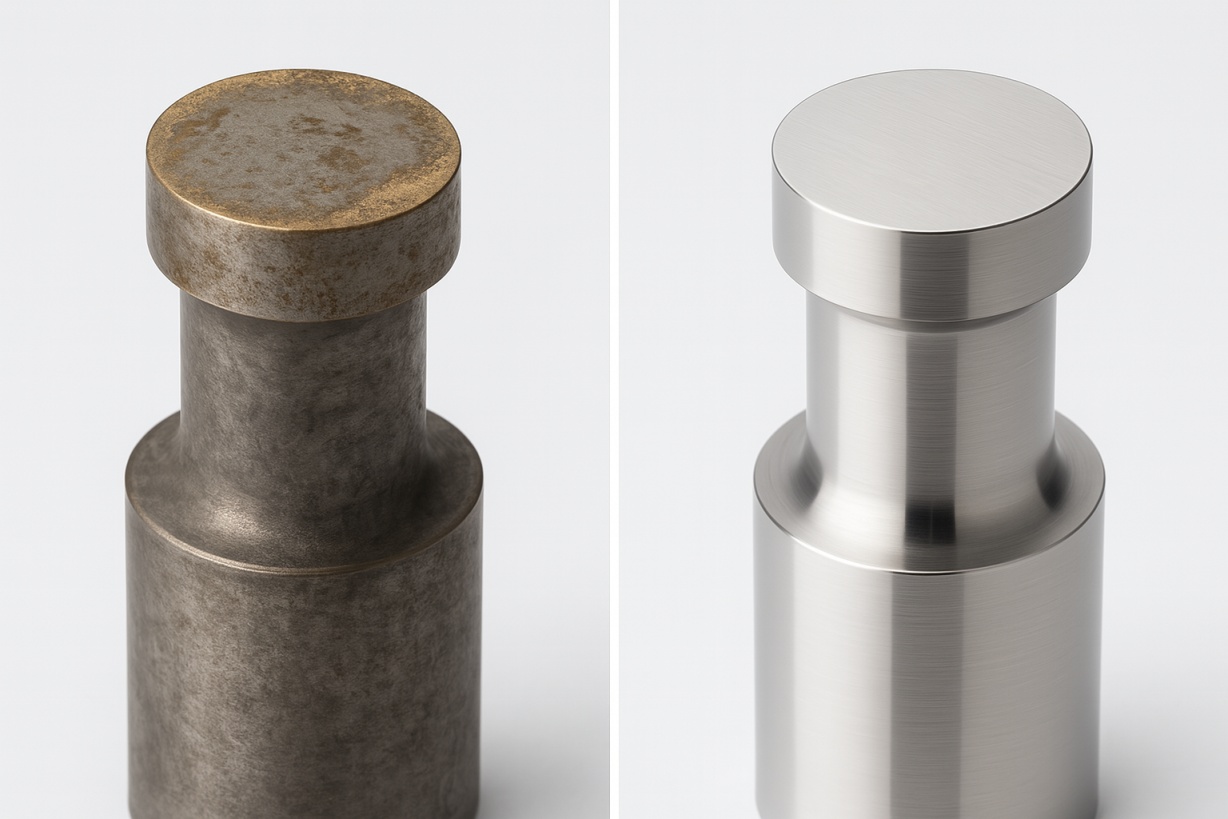Extending tablet punch life is essential for pharmaceutical manufacturers seeking to reduce costs and improve production efficiency. Tablet punch life directly impacts manufacturing costs, production efficiency, and product quality in pharmaceutical operations. While high-quality tooling represents a significant investment, proper maintenance and storage practices can extend punch life by 200-500%, dramatically improving return on investment. This comprehensive guide provides actionable strategies for extending tablet punch life through systematic maintenance protocols, optimal storage conditions, and proactive care practices that prevent premature wear and damage.

Understanding Punch Lifecycle Economics and Extending Tablet Punch Life
Cost Impact Analysis
The economic impact of extending tablet punch life extends far beyond the initial tooling investment:
Direct Cost Savings: Extending tablet punch life from 1 million to 3 million tablets reduces per-tablet tooling costs by 67%. For high-volume production, this translates to thousands of dollars in annual savings per punch set.
Indirect Cost Benefits: Reduced punch replacement frequency minimizes production downtime, changeover labor, cleaning validation requirements, and inventory carrying costs. These indirect savings often exceed direct tooling cost savings by 2-3 times.
Quality Consistency: Longer punch life provides more consistent tablet quality throughout the production campaign, reducing quality investigations, rework costs, and potential batch rejections.
Production Efficiency: Fewer tool changes increase overall equipment effectiveness (OEE) and allow for longer production runs, improving manufacturing efficiency and reducing per-unit overhead costs.
Factors Affecting Extending Tablet Punch Life
Understanding the primary factors that influence punch longevity enables targeted maintenance strategies for extending tablet punch life:
Formulation Characteristics
Abrasive excipients such as microcrystalline cellulose, dicalcium phosphate, and silica significantly impact punch wear. Formulations with poor lubrication or high binding requirements also accelerate wear through increased compression forces and surface friction.
Compression Parameters and Extending Tablet Punch Life
Excessive compression forces, rapid compression speeds, and improper dwell times contribute to premature punch failure through mechanical stress, heat generation, and surface fatigue.
Environmental Conditions
Temperature fluctuations, humidity variations, and corrosive atmospheres accelerate punch degradation through thermal stress, oxidation, and chemical attack on tooling surfaces.
Handling Practices for Extending Tablet Punch Life
Improper handling during changeovers, cleaning, and storage causes mechanical damage including chips, scratches, and impact damage that significantly reduces punch life.
Systematic Maintenance Protocols for Extending Tablet Punch Life
Daily Maintenance Procedures
Establishing consistent daily maintenance routines prevents minor issues from developing into major problems:
Visual Inspection Protocol: Begin each shift with systematic visual inspection of all punch faces, barrels, and heads. Look for signs of wear, damage, or material buildup using appropriate magnification (10x minimum). Document any observations and establish trending data to identify developing issues before they impact production.
Cleaning Procedures: Remove all tablet residue and dust from punch surfaces using approved cleaning agents and techniques. Avoid aggressive cleaning methods that might damage delicate surface finishes. Use soft brushes, lint-free cloths, and appropriate solvents selected for compatibility with punch materials and coatings.
Lubrication Management: Apply appropriate lubricants to punch barrels and cam followers according to manufacturer specifications. Use only approved lubricants and ensure proper application to prevent contamination while providing adequate protection against wear and corrosion.
Operational Monitoring: Monitor key operational parameters including ejection forces, compression forces, and tablet quality metrics. Sudden changes in these parameters often indicate developing punch problems that require immediate attention.
Weekly Comprehensive Inspections
Weekly inspections provide opportunities for more detailed assessment and preventive actions:
Dimensional Verification: Measure critical punch dimensions using calibrated equipment to identify gradual wear or dimensional drift. Focus on punch length, diameter, and critical embossed features. Establish measurement schedules based on production volume and historical wear patterns.
Surface Condition Assessment: Evaluate punch surface condition using appropriate inspection techniques including microscopy for detailed surface analysis. Look for early signs of fatigue cracking, surface roughening, or coating degradation that might not be visible during daily inspections.
Performance Trending: Analyze trending data for ejection forces, compression parameters, and tablet quality metrics to identify gradual performance degradation. Use statistical process control techniques to identify trends before they impact product quality.
Cleaning Validation: Verify cleaning effectiveness using appropriate analytical techniques or visual inspection standards. Ensure that cleaning procedures remove all residues without damaging punch surfaces or compromising subsequent production.
Monthly Deep Maintenance
Monthly maintenance activities address longer-term wear and performance issues:
Complete Disassembly and Inspection: Remove punches from the press for comprehensive inspection and maintenance. This allows access to normally hidden surfaces and enables more thorough cleaning and inspection procedures.
Precision Measurement and Documentation: Perform complete dimensional analysis using coordinate measuring machines (CMM) or other precision measurement equipment. Document all measurements and compare with baseline data to quantify wear rates and predict replacement timing.
Surface Treatment Evaluation: Assess the condition of surface treatments and coatings including chrome plating, TiN coatings, or other protective layers. Identify areas where treatments are wearing thin and plan for reapplication or replacement before substrate damage occurs.
Refurbishment Assessment: Evaluate punches for refurbishment opportunities including re-polishing, re-coating, or dimensional restoration. Many punches can be restored to near-original condition through proper refurbishment techniques.
Optimal Storage Conditions
Environmental Control Requirements
Proper storage environment control is critical for maintaining punch condition during non-use periods:
Temperature Stability: Maintain storage temperature between 65-75°F (18-24°C) with minimal fluctuation to prevent thermal stress and condensation formation. Avoid storage areas subject to heating/cooling system cycling or direct sunlight exposure.
Humidity Management: Control relative humidity between 40-60% to prevent corrosion while avoiding overly dry conditions that might promote static electricity buildup. Use dehumidification systems in humid climates and humidification in extremely dry environments.
Air Quality Control: Ensure clean air circulation with filtration to remove particulates and corrosive gases. Avoid storage near chemical processes, welding operations, or other sources of airborne contaminants that might cause surface damage or corrosion.
Vibration Isolation: Store punches in areas isolated from vibration sources that might cause impact damage or fretting corrosion. Heavy machinery, traffic, and construction activities can generate vibrations that damage stored tooling.
Storage System Design
Proper storage systems protect punches from damage while facilitating efficient inventory management:
Individual Protection: Store each punch in protective containers or foam-lined compartments that prevent contact with other tools and protect surfaces from damage. Use materials compatible with punch materials and coatings to prevent chemical reactions.
Orientation Control: Store punches in appropriate orientations to prevent damage and facilitate inspection. Vertical storage often works well for tablet punches, but specific orientations may be required based on punch geometry and coating requirements.
Inventory Management: Implement systematic inventory control with clear identification, location tracking, and condition monitoring. Use first-in-first-out (FIFO) rotation to ensure even usage and prevent extended storage that might lead to degradation.
Security and Access Control: Protect valuable tooling through appropriate security measures while ensuring authorized personnel have efficient access for inspection and retrieval. Controlled access also helps maintain environmental conditions and prevents unauthorized handling.
Packaging and Protection Methods
Effective packaging protects punches during storage and transportation:
Corrosion Protection: Apply appropriate corrosion inhibitors or protective coatings for long-term storage. VCI (Vapor Corrosion Inhibitor) papers or films provide effective protection without direct contact with punch surfaces.
Moisture Control: Use desiccants or moisture barrier packaging for extended storage periods, particularly in humid environments. Monitor desiccant condition and replace as necessary to maintain effectiveness.
Impact Protection: Provide adequate cushioning and impact protection during storage and handling. Foam inserts, custom packaging, or dedicated storage systems prevent damage from handling or environmental factors.
Identification and Documentation: Maintain clear identification and documentation with each stored punch including usage history, condition assessment, and storage date. This information supports efficient inventory management and condition monitoring.
Cleaning Best Practices
Cleaning Agent Selection
Proper cleaning agent selection balances effectiveness with punch material compatibility:
Solvent Compatibility: Select cleaning solvents compatible with punch materials and coatings. Avoid aggressive solvents that might damage surface treatments or cause substrate corrosion. Test new cleaning agents on sample pieces before general use.
Residue Removal Effectiveness: Ensure cleaning agents effectively remove all tablet residues, lubricants, and contaminants without leaving harmful residues. Validate cleaning effectiveness using appropriate analytical techniques.
Safety and Environmental Considerations: Select cleaning agents with favorable safety profiles and minimal environmental impact. Consider worker safety, disposal requirements, and regulatory compliance in cleaning agent selection.
Cost Effectiveness: Balance cleaning effectiveness with cost considerations including agent cost, labor requirements, and disposal costs. More expensive cleaning agents may provide better value through improved effectiveness or reduced labor requirements.
Cleaning Technique Optimization
Proper cleaning techniques maximize effectiveness while minimizing punch damage:
Mechanical Action Control: Use appropriate mechanical action to remove residues without damaging punch surfaces. Soft brushes, ultrasonic cleaning, or controlled abrasive techniques may be appropriate depending on contamination type and punch materials.
Temperature and Time Optimization: Optimize cleaning temperature and contact time for maximum effectiveness while preventing thermal damage to punch materials or coatings. Higher temperatures improve cleaning effectiveness but may damage some surface treatments.
Rinse and Drying Procedures: Implement thorough rinsing procedures to remove all cleaning agent residues followed by appropriate drying techniques. Inadequate rinsing can leave harmful residues while improper drying may cause water spotting or corrosion.
Validation and Documentation: Validate cleaning procedures for effectiveness and document all cleaning activities. Maintain records demonstrating cleaning validation and compliance with established procedures.
Specialized Cleaning Challenges
Certain contamination types require specialized cleaning approaches:
Tablet Picking and Sticking: Tablet material adhered to punch faces requires careful removal to prevent surface damage. Use appropriate solvents and gentle mechanical action to remove buildup without scratching or gouging punch surfaces.
Coating Residues: Film coating residues may require specialized solvents or techniques for complete removal. Some coating materials form strong bonds that resist standard cleaning procedures and require more aggressive approaches.
Corrosion Products: Corrosion products require careful removal to prevent further damage. Use appropriate chelating agents or mild acids while monitoring punch condition to prevent over-cleaning or substrate damage.
Embedded Contaminants: Hard particles embedded in punch surfaces require careful removal techniques to prevent surface damage. Ultrasonic cleaning or specialized extraction techniques may be necessary.
Handling and Transportation Guidelines
Safe Handling Procedures
Proper handling prevents damage during routine operations:
Lifting and Carrying Techniques: Use appropriate lifting techniques and equipment to prevent dropping or impact damage. Heavy punches may require mechanical assistance or team lifting procedures to ensure safe handling.
Installation and Removal Procedures: Follow established procedures for punch installation and removal to prevent damage to punches or press components. Use appropriate tools and techniques specified by equipment manufacturers.
Inspection During Handling: Inspect punches during handling operations to identify damage or wear that might require immediate attention. Early identification prevents further damage and quality issues.
Training and Competency: Ensure all personnel handling punches receive appropriate training and demonstrate competency in safe handling procedures. Regular refresher training maintains awareness and prevents complacency.
Transportation Protection
Protect punches during transportation between storage, maintenance, and production areas:
Secure Packaging: Use appropriate packaging that secures punches during transportation while protecting surfaces from damage. Avoid packaging that allows movement or contact between punches.
Route Planning: Plan transportation routes to minimize vibration, shock, and environmental exposure. Avoid routes through areas with potential contamination sources or extreme environmental conditions.
Handling Equipment: Use appropriate handling equipment including carts, containers, or specialized transport systems designed for precision tooling. Ensure equipment is clean and in good condition before use.
Documentation and Tracking: Maintain documentation tracking punch movement and condition during transportation. This supports accountability and helps identify sources of damage if problems occur.
Wear Pattern Analysis and Trending
Systematic Wear Monitoring
Implementing systematic wear monitoring enables proactive maintenance decisions:
Measurement Protocols: Establish systematic measurement protocols for tracking critical punch dimensions over time. Use statistical process control techniques to identify trends and predict replacement timing.
Photography Documentation: Maintain photographic records of punch condition over time to document wear progression and identify developing problems. Consistent lighting and positioning enable meaningful comparisons.
Performance Correlation: Correlate punch wear measurements with tablet quality parameters and production metrics to understand the relationship between tool condition and product quality.
Predictive Modeling: Develop predictive models based on historical wear data to forecast replacement timing and optimize maintenance schedules. These models support proactive planning and cost optimization.
Data Analysis and Decision Making
Effective data analysis supports optimal maintenance decisions:
Trend Analysis: Analyze wear trends to identify accelerating degradation or unusual wear patterns that might indicate process problems or maintenance opportunities.
Comparative Analysis: Compare wear patterns between different punch sets, formulations, or operating conditions to identify optimization opportunities and best practices.
Economic Optimization: Use wear data and cost information to optimize replacement timing based on total cost of ownership rather than arbitrary replacement intervals.
Root Cause Analysis: Investigate unusual wear patterns or premature failures to identify and correct underlying causes. This prevents similar problems and optimizes overall tooling performance.
Proactive Replacement Strategies
Condition-Based Replacement
Move beyond calendar-based replacement to condition-based strategies:
Wear Limit Establishment: Establish specific wear limits based on product quality requirements rather than arbitrary limits. These limits should balance quality maintenance with tooling life optimization.
Multi-Parameter Assessment: Consider multiple parameters including dimensional wear, surface condition, and performance metrics when making replacement decisions. Single-parameter decisions may miss important degradation modes.
Risk Assessment: Assess the risk of continued operation versus replacement cost to optimize replacement timing. Higher-risk applications may justify earlier replacement while low-risk applications can extend service life.
Quality Impact Evaluation: Monitor the relationship between punch condition and tablet quality to optimize replacement timing based on quality impact rather than predetermined schedules.
Inventory Optimization
Optimize punch inventory to balance availability with carrying costs:
Lead Time Management: Plan punch procurement based on predicted replacement timing and supplier lead times to ensure availability without excessive inventory.
Standardization Benefits: Standardize punch designs where possible to reduce inventory complexity and improve utilization efficiency. Fewer unique designs reduce inventory requirements and carrying costs.
Refurbishment Integration: Integrate refurbishment capabilities into inventory planning to extend effective inventory life and reduce procurement requirements.
Emergency Preparedness: Maintain appropriate emergency inventory for critical applications while avoiding excessive safety stock that increases carrying costs.
Cost-Benefit Analysis Framework
Lifecycle Cost Modeling
Develop comprehensive lifecycle cost models to optimize maintenance investments:
Total Cost Components: Include all cost components including initial tooling cost, maintenance costs, replacement costs, downtime costs, and quality costs in lifecycle analysis.
Maintenance Investment Optimization: Determine optimal maintenance investment levels by comparing maintenance costs with extended life benefits and avoided replacement costs.
Performance Monitoring ROI: Calculate return on investment for performance monitoring systems and preventive maintenance programs to justify investment and optimize resource allocation.
Continuous Improvement Benefits: Quantify benefits from continuous improvement initiatives including reduced downtime, improved quality, and extended tooling life.
Decision Support Tools
Implement decision support tools to guide maintenance and replacement decisions:
Economic Decision Models: Develop economic models that support maintenance and replacement decisions based on comprehensive cost-benefit analysis rather than simple cost minimization.
Risk-Based Prioritization: Prioritize maintenance activities based on risk assessment considering production impact, quality risk, and economic consequences of failure.
Resource Allocation Optimization: Optimize maintenance resource allocation across multiple punch sets and production lines based on economic analysis and risk assessment.
Performance Benchmarking: Benchmark performance against industry standards and best practices to identify improvement opportunities and validate current practices.
Conclusion
Extending tablet punch life through systematic maintenance and proper storage practices represents one of the most cost-effective strategies for optimizing pharmaceutical manufacturing operations. The potential for 200-500% life extension through proper care practices provides substantial return on investment while improving production efficiency and product quality consistency.
Success requires a comprehensive approach that addresses all aspects of punch care from daily maintenance through long-term storage and eventual replacement. The key lies in implementing systematic procedures, training personnel properly, and maintaining consistent execution over time.
The economic benefits extend far beyond simple tooling cost savings to include reduced downtime, improved quality consistency, enhanced production efficiency, and better resource utilization. These benefits compound over time, making investment in proper punch care practices one of the highest-return activities in pharmaceutical manufacturing.
As manufacturing costs continue to increase and quality requirements become more stringent, the importance of maximizing tooling life will only grow. Organizations that invest in developing comprehensive punch care capabilities will achieve significant competitive advantages through lower costs, higher quality, and improved operational efficiency.
The future of tablet punch management lies in increasingly sophisticated monitoring, predictive maintenance, and data-driven decision making. By implementing the practices outlined in this guide, manufacturers can build the foundation for these advanced approaches while achieving immediate benefits from improved punch care.
Related Resources
- Tablet Press Maintenance Guide
- Pharmaceutical Manufacturing Best Practices
- Quality Control in Tablet Production
For specialized consultation on developing comprehensive tablet punch maintenance programs and extending tablet punch life optimization strategies, contact our technical experts for customized solutions tailored to your specific operations.

